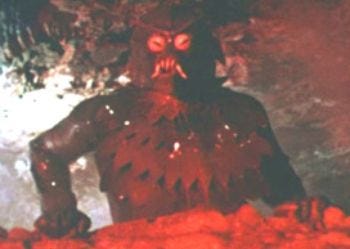It's Alive! (1969)

Not to be confused with Larry Cohen's 1974 killer baby flick of the same name, "It's Alive!" is one of those films we schlock lovers call "bad bad."
The film starts off with a pointless opening narration about how there's an old legend about when it rains while the sun is out, it means the devil is kissing his wife. What that has to do with the rest of the film, I don't know (and I didn't even know old Satan was dating, much less had settled down...and what kind of a woman would marry Satan anyway?).
The film follows the high-falutin' city couple Norman and Leilla Sterns (Corveth Ousterhouse and Shirley Bonne) whose drive in the country goes wrong when they stumble upon a man named Greevy, who has a proclivity for capturing and caging wild animals (whom he carries on conversations with; never a good sign for wayward travellers).
His prized possession, though, is some sort of reptilian monster that he keeps in a cave, and kind of resembles a man in a 60s-era Halloween-costume version of a Creature from the Black Lagoon suit if it had been left out in the sun for too long.
This creature, of course, requires sustenance, so Greevy feeds him those stranded motorists who apparently pop up at his house from time to time (this obviously happens often, unless the creature has a particularly slow digestive system).
He lures our couple into the cave and locks them in a cell along with a good samaritan/paleontologist named Wayne (Tommy Kirk) who foolishly directed them to Greevy's home for help in the first place.
From there the film unravels in a wanton display of dunderheaded plot holes and the worst character development you'll ever see. Norman is a prototypical big-city asshole, berating his wife and blaming her for getting them lost (even though he was the one driving), and being rude as a guest in someone else's house (at one point, when Greevy's "wife" Bella (Annabelle MacAdams) declines his request to open the drapes, leading him to take them from her and rip them open, shouting "it's like a tomb in here!").
Fear not, though, as he's dispatched by the monster in short order in the first of exactly two appearances the beast makes in the film (I'd estimate the title character's screen time at less than a minute altogether), leaving Leilla and Wayne to become an item, which they do apparently in the next sequence, as she casually lays next to him, stroking his hair lovingly. The pair shares a casual coffee-cup toast moments after that--mind you, her husband was eaten alive in front of both of them only moments earlier, not to mention wondering where, in this dank, dark holding cell constructed in a cave where they're being held prisoner where they got a cup of coffee in the first place.
Greevy looks like the offspring of a (totally hypothetical) night of wanton, drunken passion between Glenn Ford, Bill Murray, and Dick the Bruiser, and enunciates in true style of the latter, barking and grunting his lines out like he's gotta visit the can immediately after.
Two completely mystifying developments in the film: 1) Wayne is shot at the beginning of the film. Not only does he not die immediately (as is customary of films of this era), but we never see a bullet wound, blood, or even another mention of it the rest of the film. 2) Greevy and Bella (the former to taunt and terrorize, the latter to express a panicked wish that she could save them) show up in the cell with our heroes repeatedly throughout the film, and there is mention made of tunnels connecting the house and the cave. Again, they simply appear in the cell, without opening the door. Why wouldn't Wayne and Leilla just follow them out, to their immediate escape?
Finally, we get an extended and utterly pointless run-time-padding sequence detailing how Bella came into Greevy's capture. Much of the sequence is wordless, beginning with narration, then segueing into a musical soundtrack. Bella and Greevy speak through much of this, but we don't hear what they're saying.
Of course The Schlock Vault knows that there are hundreds of good bad movies out there. This one, though, is strictly bad bad.


